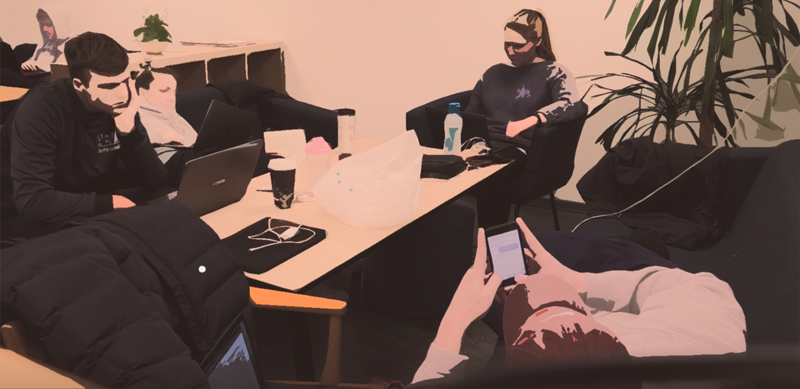Within educational technology, research has previously centred on how educators design technology-supported teaching and, to a lesser extent, on students' self- organised digital practices. Students increasingly use technology to organise learning and bring informal digital practices into a formal educational arena. At the same time, research into students' digital practices has focused on mapping which technologies students use. In contrast, we still have only limited insight into how and why they use the specific technologies and how these affect their learning.
Technology has become an integral part of education. While it may have previously made sense to consider online and onsite as two separate domains, students are increasingly working in hybrid learning environments. Here, online and onsite are interwoven so that they cannot be understood in isolation. Research on student digital practice has focused primarily on individual practice rather than digital collaborative practice. Furthermore, research into collaborative learning groups tends to focus on either online collaboration or face-to-face collaboration, while a smaller proportion deals with collaboration in a hybrid learning environment.
This dissertation explores student self-organized hybrid collaborative practices in a problem-oriented and project-based learning environment. It reports a multi-sited ethnographic study of student orchestration of collaboration and the role of technology in collaboration. At Aalborg University (AAU), Denmark, students work under the AAU model, a problem-oriented and project-based pedagogical model; the students collaborate in small groups on an authentic problem of their choice, often for a semester (three to four months). The model implies a high degree of student autonomy; the students manage how they collaborate on the project, including meeting place, meeting frequency, planning, division of labour, work constellations (individually, in pairs, together in the group), choice of technology, and how they use technology to support their project collaboration. The students collaborating on a problem-based project are examples of students applying the technology to active learning. Research indicates that students, on the one hand, need support to develop their digital practices and, on the other hand, develop small creative practices that we as researchers and educators can learn from. Throughout a semester, from group formation to project exams, I have followed project groups across onsite meetings and digital platforms. The participating groups are selected across the five faculties at AAU.
The studies show a high degree of diversity in the students' collaborative practice in and among the participating project groups. In the dissertation, you will encounter:
- Project groups that work closely together and project groups that primarily cooperatively divide the tasks among the individual members
- Project groups that meet daily and project groups that meet weekly
- Project groups that meet in group rooms, at home with group members, meeting rooms, the library, and virtually
- Project groups that work with a fixed work division and fixed work constellations and project groups in which work division and constellations are dynamically changing
- Project groups with a collaborative practice characterised by routines and project groups with a practice characterised by navigation in the present and an ad-hoc structure emerging due to the given situation
In this dissertation, I focus on the actual practice of the students. In technology and education, there is a tendency to focus on what technology does in education and learning and how technology improves or degrades education (most often the first). In practice, however, technology appears more like an expected and unremarkable element of education. I have taken an exploratory and adaptive approach to the study, focusing on describing the students' collaborative practice in addition to normative and deterministic considerations about technology, education, or students' ability to use technology for learning, with the primary purpose of developing new concepts and models helping to explain student practices.
The dissertation offers empirical examples and descriptions from the field of student collaborative practice, which, through analysis and in the dialogue between data and ideas, has turned into categories, concepts, and models. Among other things, I propose an understanding of the student collaboration as balancing the six dimensions: social – academic, PBL collaboration – PBL cooperation, individual – shared, planning – improvisation, routine – ad-hoc, and together – apart. The dimensions substantiate that the project work can take several forms and show that no ideal balance exists for the project groups to strive for. The six dimensions of group work have both analytical and more practical potential by forming basic analytical questions for students' collaborative practice and questions that require students to reflect on their collaborative practice.
Furthermore, the dissertation shows that a linear causality thinking between technology and practice can be problematic, and it is impossible to give an unambiguous answer to the question of what technology does or brings to the students' collaboration. It supports the notion that technology plays a vital role in student collaboration and provides various examples. The technology can help structure the collaboration while simultaneously offering flexibility and demanding fluidity. Digital and analogue technologies constitute, individually and in interplay, essential tools in project work. In addition, technology can act as a place and plays an essential role in students' construction of the workplace. It emphasises that the use of technology to support project collaboration cannot be reduced to choosing the right tools and using them in the right way. It is also about constructing a workplace and creating a space for learning and collaboration. This workplace construction implies negotiating the boundaries between onsite and online and between contexts and roles within and outside the university.

